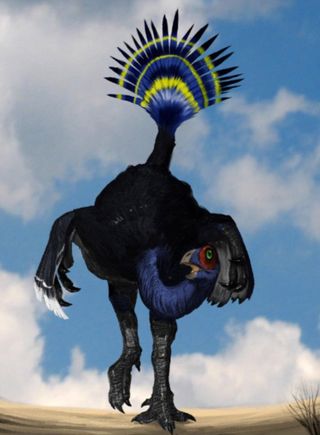Shake, Shake, Shake: Dinosaur Flirting Technique Revealed

LAS VEGAS — A dinosaur best known as an egg thief may have also been a showy diva with a feathery tail like the fan of a flamenco dancer, a new study finds.
Oviraptor dinosaurs lived in the late Cretaceous Period, about 75 million years ago. They got their name, Latin for "egg thief," because the first specimen was found near a clutch of eggs as if the beast were stealing them; later discoveries revealed that the eggs were likely oviraptor's own, though the dinosaur's diet, and whether it included eggs, is mostly unknown.
But the new research finds that whatever they ate, oviraptorids were experts at shaking their tail feather. The dinosaurs have unusually compact, flexible tails, said study researcher Scott Persons, a doctoral student at the University of Alberta. Combined with a fan of feathers attached to the tail's end, this would have enabled Oviraptor to put on a show similar to that of a modern-day peacock.
Persons, who presented his research Nov. 2 here at the Society for Vertebrate Paleontology's annual meeting, began studying the tails of various species of Oviraptor as part of a larger study on the tails of all theropods, a group of dinosaurs related closely to modern-day birds. Oviraptors are interesting, Persons told LiveScience, because they have very odd tails with a strange arrangement of bones.
"The tail of an Oviraptor by comparison to the tail of most other dinosaurs is pretty darn short," he said. "But it's not short in that it's missing a whole bunch of vertebrae, it's short in that the individual vertebra within the tail themselves are sort of squashed together. So they're densely packed."
That dense bone arrangement would have made the tails especially flexible, Persons said, in the same way that a person's spine with its many bone junctions can move more sinuously than an arm, which has only a couple of joints.
In addition, comparison with the tails of modern-day reptiles suggests that oviraptorids had particularly muscular tails, Persons said. Fossil impressions reveal that oviraptorids also came equipped with a fan of feathers at the end of their tails, attached to a hunk of fused vertebrae not unlike those found in the tails of modern-day birds.
Sign up for the Live Science daily newsletter now
Get the world’s most fascinating discoveries delivered straight to your inbox.
"If you combine that with having a muscular, very flexible tail, what you have is a tail that could, potentially at least, have been used to flaunt, to wave that tail-feather fan," Persons said.
And just like modern-day birds, oviraptorids may well have flashed their tail fans to impress potential mates.
"If you think about things like peacocks, they often use their tails in courtship displays," Persons said.
You can follow LiveScience senior writer Stephanie Pappas on Twitter @sipappas. Follow LiveScience for the latest in science news and discoveries on Twitter @livescience and on Facebook.

Stephanie Pappas is a contributing writer for Live Science, covering topics ranging from geoscience to archaeology to the human brain and behavior. She was previously a senior writer for Live Science but is now a freelancer based in Denver, Colorado, and regularly contributes to Scientific American and The Monitor, the monthly magazine of the American Psychological Association. Stephanie received a bachelor's degree in psychology from the University of South Carolina and a graduate certificate in science communication from the University of California, Santa Cruz.
Most Popular


